What is a filter, and how do I use one in Neoserra?
In Neoserra, a filter is used when you want to isolate certain record types based upon criteria set forth by you. For example, you could create a filter to look for all active clients that are woman-owned in a particular county or congressional district.
There is no limit to the number of criteria you can specify when creating a filter; the more criteria you string together, the more specific and narrow the results of your filter will be.
Filters are created per record type, however, you can use a saved filter from one record type in another record type. For example, you could first create a filter of all veteran-owned clients, and then use that filter to identify all the counseling session conducted with these clients.
- How do I create a filter?
- How do I specify my filter criteria?
- How do I filter across multiple Centers?
- How do I know which clients received certain activity?
- How do I save my filter?
- How do I, as an administrator, use Boolean logic in my filter?
How do I create a filter?
There are a few built-in filters provided in the Neoserra application but most of the time you will want to create your own custom filter based upon the type of records you want to look at as described in detail below.
- You can create a new filter by selecting Filter|Create Filter from any of the data forms. Below you will see a screenshot from the client form interface, however, you would follow the exact same steps if you want to create a training event filter, or counseling filter, etc.:

Alternatively, you can click on the "blue ribbon" at the top of the listing and edit an existing filter that is currently in effect:

- Once you open the filter interface then you can select the parameters that you want to search on:
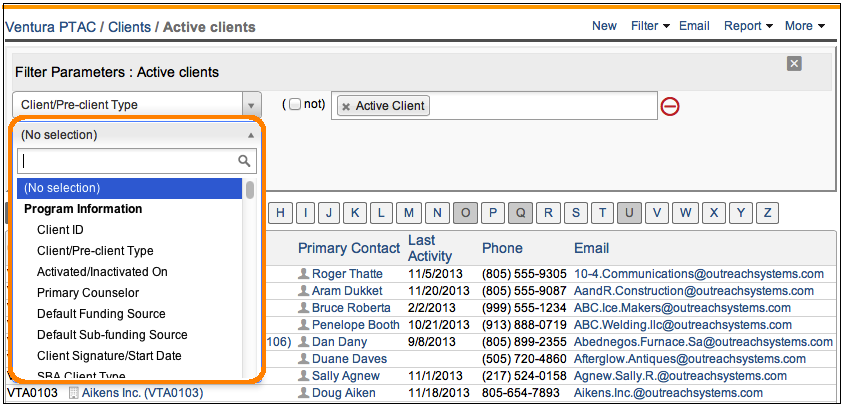
- You will want to decide what field you would like to include in your filter. You can choose from any field normally available within that record type. For example, when you are filtering your clients, you can choose any of the client fields in your filter; when you are filtering your training events, you can choose any of the training event fields in your filter. Simply click on the No selection drop down and pick the field that will be part of your filter:
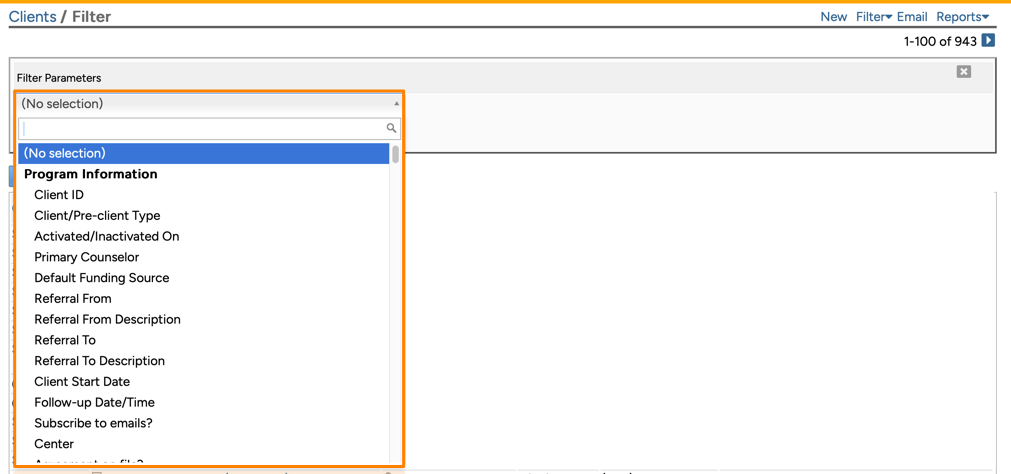
- You can type the first few letters of a field that you want to filter on and all applicable options will appear:
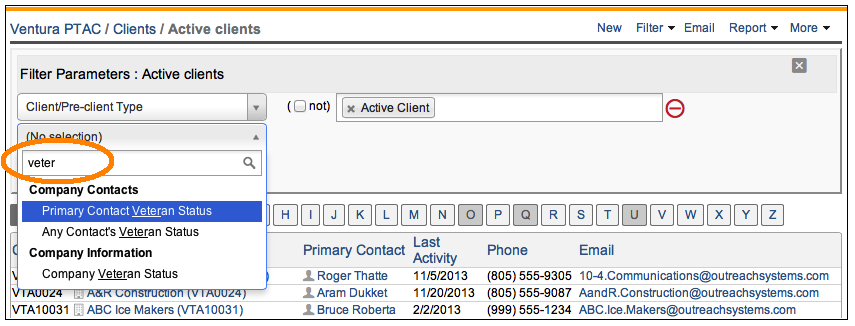
- On the left hand side of the expression, you are selecting the search parameter, on the right hand side of the expression you are selecting the search value:

- Next to the filter value you will see the (not) checkbox:
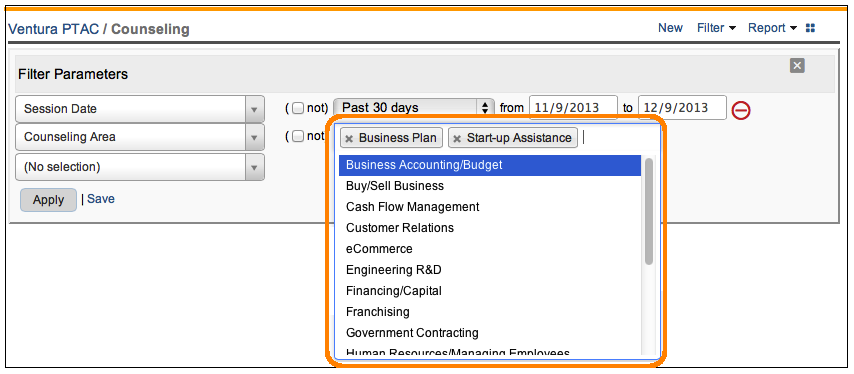
When selected, this option indicates that the filter should return all records that do NOT match the criteria specified. In the example above, when you click Apply, you will get all results where the client's business size is not set to "Large".
- To remove a filter you can click the red "stop" sign that can be found on the far right of each filter value:
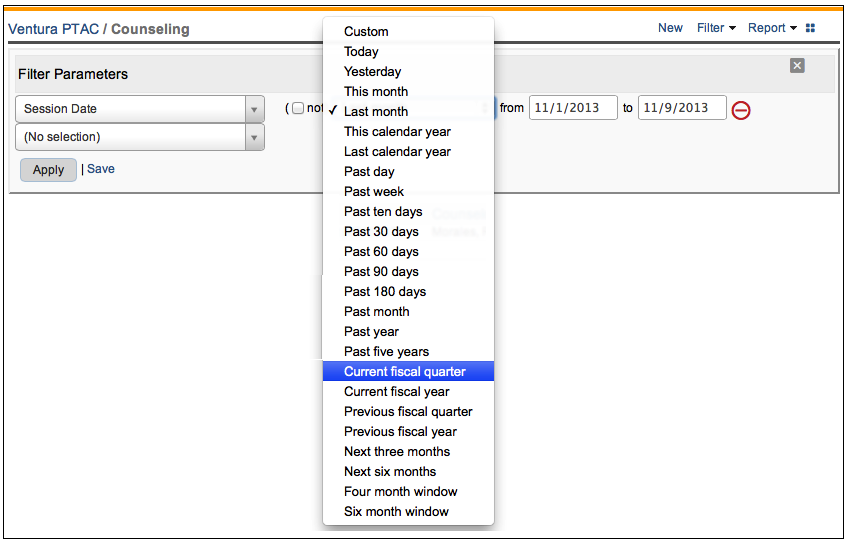
How do I specify my filter criteria?
Each line within a filter consists of a filter parameter and a filter value. If you have multiple lines within a filter then these lines are all ANDed together. Thus, in this filter, we are looking for all clients that are active AND they are in-business AND they are located in the county of Santa Barbara:

But notice, that the concept of being in business is defined by two different options: "Start-up (in bus < year)" OR "In-business (> 1 year)":

If there is more than one value selected per parameter, then these are all seen as OR statements. Thus, any client whose Company Status is either set to "Start-up (in bus < year)" OR whose Company Status is set to "In-business (> 1 year)" will match (assuming that the other parameters also match).
Not every field, however, is a picklist. You may also want to search for all clients with a business start date since 1/1/25; or you may want to search for all clients who is "Verified to be in business?", which is a Yes/No field; or you may want to search for all clients with "electrical engineering" in their product/services description field. There are four different field types that you can filter on:
Drop Down or Picklist Fields
When drop down fields are included in your filter, you can select as many selections as you wish. Simply click your mouse in the field and all choices will be presented, choose one and put your mouse back in the field and choose your next choice. For example, if you want to filter counseling session records based on the Counseling Area field, all counseling area types are presented in the drop down, choose as many as you want to include, as shown in the following graphic:

Selecting multiple choices creates an "or" statement. Thus, if you were to select "Business Plan" and "Start-up Assistance," Neoserra would return counseling session records of either type.
Date Fields
When date fields are included in your filter, Neoserra presents you with a long list of commonly used date ranges, or you can choose Custom and enter your own date range:
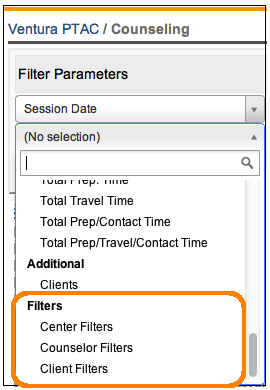
Using your own custom date range, you can specify an open-ended date range (i.e. consider all records in the system entered before or after a particular date) by clearing either the start or end date.
Free-form Text Fields
When free-form text fields such as company name or a person's name are included in your filter, you'll need to use the asterisk as a wildcard at the front and at the end of your search term to ensure a match.
You can place commas (,) between your keywords to create an "or" statement for that particular filter text field. For example, as shown in the next graphic, you could enter something like *james*,*jim* in the text field criteria. This would return all contact records with either of these names in the first name field.

But what if you actually want to search for a comma? Then you can use the [COMMA] substitution variable as a search term.
There are a number of system-defined free-form text fields, the name of the company or person are, of course, a free-form fields, but you can use the same technique on the Referral Description, Product Description or Notes fields. In fact, for those programs using our Bid Matching services, you can even search the Bid Match criteria using the same method, as described here.
Keep in mind that the words between the asterisk must match EXACTLY to the words in the field. For example, searching for: *electrical engineering* will NOT match on "electronics engineering:"

String searching requires there to be a perfect match between the filter parameter and the data value in the field being searched.
Yes/No Check Box Fields
When yes/no check box fields such as the "Reportable" field are included in your filter, then just by virtue of including them, it is assumed you want all records for which the check box is checked (i.e. where the choice is set to Yes):

If you want the opposite, and you want all record where the check box is NOT checked then you would mark the (not) box:

How do I filter across multiple Centers?
By default, you will always only get search results for the center in which you are operating:

In the example above, we are filtering for all counseling session within the 1/1/25 - 12/31/25 period that are reportable AND where the counseling session is associated with the Malibu center. The top level filter for the "Malibu Center" is implied because we are currently working in the Malibu center.
Depending upon your permissions, you can either change your center selection at the top and then the results will be based upon the new center, or you can include a "Center" filter parameter in your search and include as many of the centers that you have permissions to:

You must have the appropriate permissions for each of the centers selected.
In addition to the "Center" filter parameter, Neoserra also offers the "Centers" filter parameter (notice the plurality). The Centers filter parameter offers a choice of "All permitted centers":

How do I know which clients received certain activity?
This is where it gets interesting. Let's say you created the below filter to find all SBA Loans that were approved this year:
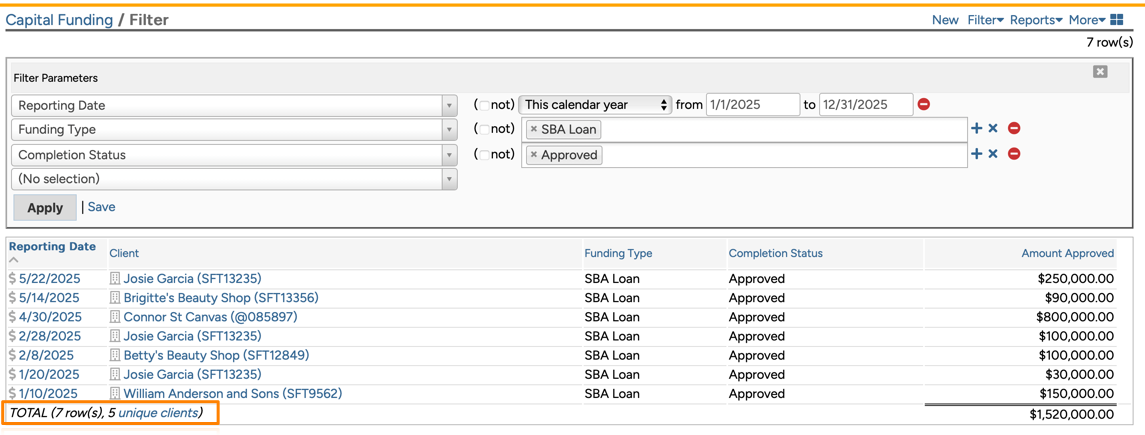
You will notice that there were 7 loans approved but there are only 5 unique clients that received these loans. What if you want to send these 5 clients a congratulatory email, then you don't want to send the same email multiple times to the client who received multiple loans. You will only want to send one email to each client.
At the bottom of the page, you will see a "Unique Clients" link which will take you to the client page where only the 5 unique clients will be listed:

You can see that the client filter references back to the capital funding filter.
How do I save my filter?
If you are creating a filter that you want to use again in the future, then you can save your filter criteria by clicking on the Save button and entering a descriptive name into the adjacent Name field. In fact, we recommend that your naming convention reflect every selected criteria of the filter so that you and others always know exactly what parameters and values were used to create the filter.
Note: When you save a filter, you are not saving the listing of records that was produced as a result of generating the filter. Rather, you are saving the filter criteria. In other words, each time you run a saved filter, you could see slightly different results depending upon rolling time frames or newly-added records.
To learn more about managing and sharing saved filters, view the FAQ titled Can I save my filter for future use or to share it with other Neoserra users?.
How do I, as an administrator, use Boolean logic in my filter?
As noted above, by default all Neoserra filters are created as AND statement. However, have you ever wanted to search for all clients who are EITHER woman-owned OR veteran-owned? Have you ever wanted to search for all clients that have EITHER been referred to you by the local Chamber of Commerce OR who you referred to the local Chamber of Commerce? This type of OR logic is available to administrators using the advanced filter interface.
Administrators that are familiar with Boolean logic and nested expressions can, optionally, turn on the "Advanced filter interface" under their Personal Preferences:
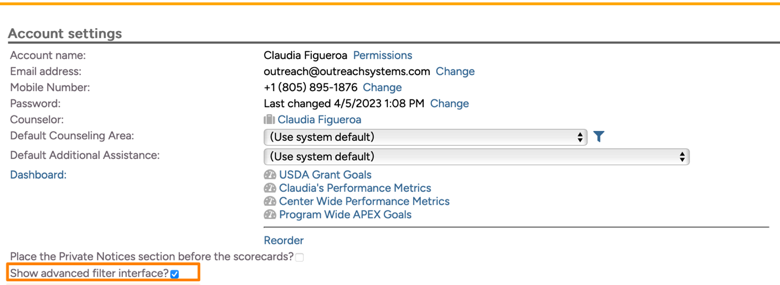
Turning on the advanced logic means that you are turning on the ability to add Boolean logic to your filter expressions:

Boolean logic is a form of algebra that is centered around two simple words known as Boolean Operators: "OR" & "AND". These Boolean logic operators logically combine your keywords in a filter to help broaden or narrow its scope:

When you are using both "AND" and "OR" operators, it is generally best to enclose the "OR" parameters with parentheses (as shown above). This is best explained when ordering breakfast! You ask the wait staff what they recommend, and the recommendation is: "Eggs and bacon or sausage." We can only assume they mean "eggs and bacon" or "eggs and sausage":
 OR
OR 
However, in algebra, the emphasis is always given to the "AND" operator. Thus, in Boolean logic, a statement such as "Eggs AND bacon OR sausage" will be interpreted as:
 OR
OR 
Parentheses are necessary to place emphasis on a specific grouping of parameters by prioritizing the information within them, followed by information outside the parentheses. When you are using both "AND" and "OR" operators, it is generally best to enclose the "OR" parameters with parentheses. Thus, logically speaking it would be written as:
- Eggs AND (bacon OR sausage)
And when we use variables, it would look like:
- (A) AND ((B) OR (C))
And within Neoserra, that looks like:

Neoserra does not know when you want to use the OR operator, thus, by default, it assumes that all parameters should be "ANDed" together. If you want to add an OR operator, then it is up to you to add it and to ensure that the parenthesis are properly placed. And take note of the sausage example above, the absence of parentheses around OR statements, or badly placed parentheses, will create unexpected and incorrect results.
If you remove parameters without updating the Boolean logic then you may get an error. Once you turn on the additional functionality supporting Boolean logic then it becomes the user's responsibility to create valid logic. Take the following example, initially the are four parameters and the logic works correctly. However, once the user removes one of the parameters the logic becomes non-sensical. If you nonetheless click "Apply" then Neoserra will generate an error indicating that there is bad logic:
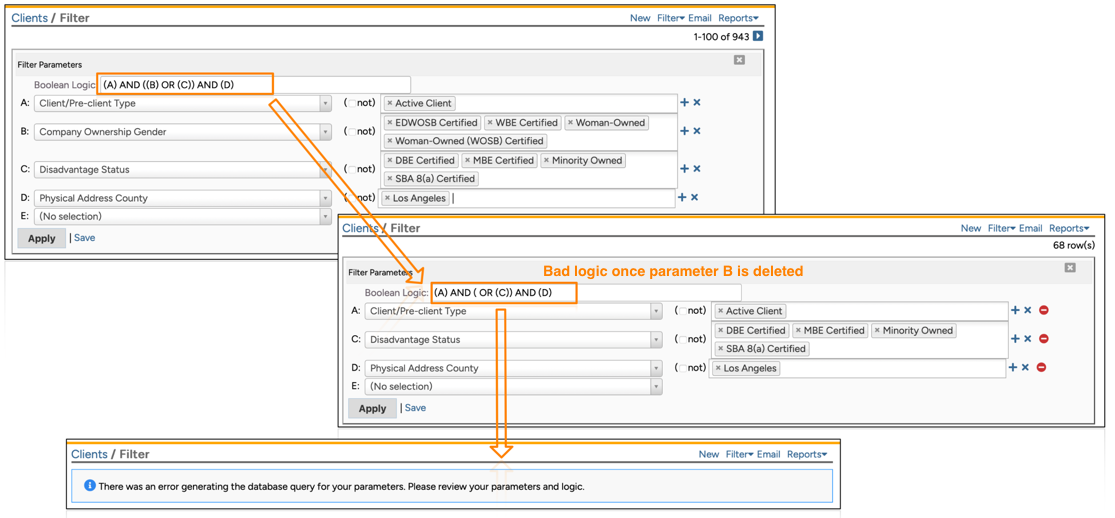
Once you have created a filter that includes Boolean logic, you can save it and expose it to your other users to use. While non-administrators cannot create filters with Boolean logic, they are able to run filters that are shared with them that include Boolean logic.
Want more? Browse our extensive list of Neoserra FAQs.
